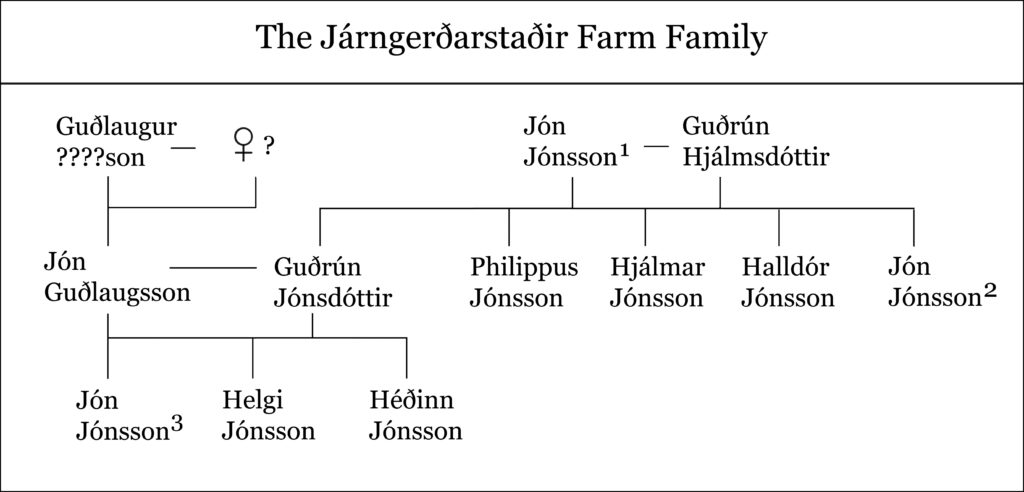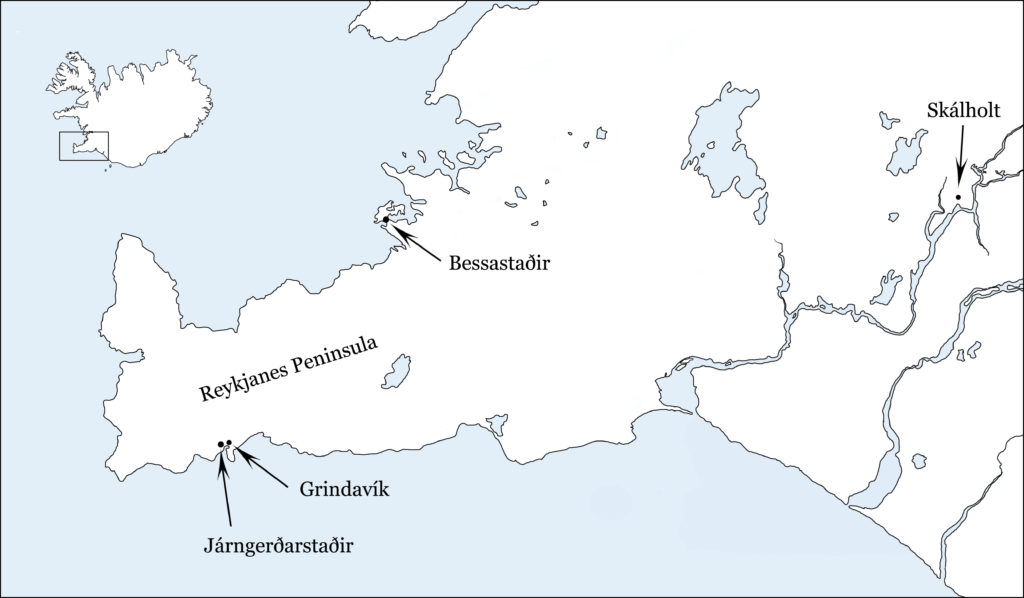On Wednesday, June 20,1 1627, Barbary corsairs raided the village of Grindavík on Iceland’s southwest coast. These corsairs had come from Salé, on the west coast of Morocco, a sailing distance of something like 2,000 miles (3,300 kilometers), much of it across the heaving North Atlantic.
In the early seventeenth century, Iceland had no cities. It didn’t even have much in the way of towns. Mostly, people lived in individual farms or in small village communities along the coast. Grindavík, located on the southern shore of the Reykjanes Peninsula in Iceland’s southwest corner (see the map below), was one such community. It was the site of a Danish trading post (Iceland was a Danish possession at the time, and the Danes exercised a complete monopoly over trade). Beyond the houses of the trading post, there wasn’t much else beside scattered farms. The largest and most important of these was a place called Járngerðarstaðir (pronounced Yawrn-gerthar-stathir). Járngerðarstaðir literally means “iron-making area,” for there had been an iron smelter there during the Viking Settlement Period and into the Middle Ages.
Járngerðarstaðir farmstead was part of the property owned by the Skálholt See. Skálholt, located a little over 60 miles (about 100 kilometers) northeast of Grindavík (see the map below), was one of Iceland’s two Episcopal Sees (the other being Hólar, in Hjaltadalur in North Iceland). Skálholt was the place where the Bishop of Southern Iceland had his seat, but it was also a political and cultural center, and it housed Iceland’s first university (Skálholtsskóli, founded in 1056, to educate clergy). The Járngerðarstaðir farmstead was large and prosperous, and the ‘tenant farmers’ who operated it for the Bishop would have been important people.
Icelanders don’t have family names. Instead, they use patronymics (e.g., Jón Jónsson—John, John’s son) and matronymics (e.g., Guðrún Jónsdóttir—Gudrun, John’s daughter). So we can’t refer to the family who operated Járngerðarstaðir Farm in the 1620s by a family name. As a result we’re forced to refer to them as the Járngerðarstaðir Farm family.
With the exception of a few famous men (like Miguel De Cervantes, author of Don Quixote), the individuals captured in seventeenth century corsair raids remain almost entirely anonymous and unchronicled. The Járngerðarstaðir Farm family members are an exception to this. Thanks to a collection of seventeenth century Icelandic documents—two of them penned by members of the family—that were created while events were still fresh in people’s memories, we can trace the details of what happened to the Járngerðarstaðir Farm family on that fateful June day in 1627 and afterwards.
Before we get to the details of the travails they endured, though, we first have to identify the members of the family, for the lives of two generations were upended.
Typically for the times, the Járngerðarstaðir Farm family was multigenerational: grandparents, parents, and children. When the Salé corsairs attacked, the youngest generation were early adults but had not yet started families of their own (at least there is no record of those families). Below is a chart of the Járngerðarstaðir family. Of the four grandparents, only two are clearly named in the Icelandic documents.
The middle generation of the Járngerðarstaðir Farm family consisted of Jón Guðlaugsson and Guðrún Jónsdóttir—husband and wife—and Guðrún’s four brothers. Jón Guðlaugsson’s father is never named, but given the Icelandic practice of patronymics, his father must have been Guðlaugur Somebody’s-Son (quite likely Guðlaugur Jónsson, for Icelanders have a habit of alternating names through the generations). Guðrún’s father, Jón Jónsson, was a parson at Grindavík (see the map below). To occupy such a position, he would have had to have been an educated, influential, and likely well-to-do man from an important family. His daughter, Guðrún, would have been a ‘catch.’
The Icelandic texts say nothing about the parents of Jón Guðlaugsson (Guðrún’s husband), but Jón himself is described as a carpenter and as coming from a lineage of important farmers. There is no mention in the Icelandic texts of him having any siblings, but it would have been most unusual for him not to. His and Guðrún’s marriage probably served as a means to ally two powerful families. Jón is described as “elderly” in the Icelandic texts. Guðrún’s sons were grown men, but since there is no mention of them having families of their own, and since the oldest had recently graduated from university, they were likely in their early twenties, perhaps even late teens. This would probably put Guðrún in her early forties or thereabouts. Her husband, Jón, was quite possibly a whole generation older than her, perhaps even a friend of her father’s. This seems a little creepy today, but it was not uncommon at the time for older men to have much younger wives, often because their first wives had died in childbirth or of disease. (Reverend Ólafur Egilsson, author of one of the contemporary Icelandic texts on the corsair raid, had done just this after his first wife’s death.)
Given Guðrún’s likely age, her four brothers—Philippus Jónsson, Hjálmar Jónsson, Halldór Jónsson, and Jón Jónsson (all with the same patronymic, Jónsson, from their father, Jón Jónsson)—were grown men in their thirties or forties. The Icelandic texts mention that Halldór was married and had two young children. The other brothers were doubtless married with children as well, but there is no clear record of this.
(As is typically the case with seventeenth century documents, the Icelandic texts were written by men, about men, for men, so there is little mention of women or children. The fact that the Járngerðarstaðir Farm family seems to be composed mostly of men is surely an artifact of this male-centric skew in the documents.)
Guðrún had three sons: Jón Jónsson, Helgi Jónsson, and Héðinn Jónsson (all with the same patronymic, Jónsson, from their father, Jón Guðlaugsson). There is no mention of her having any daughters.
As you can see, “Jón” was a common name. Icelandic records from this time are littered with “Jón Jónssons.” To help keep track of them, I’ve tagged the various Jón Jónssons by generation: Jón Jónsson1 is Guðrún’s father (generation one, the grandparents’ generation). Jón Jónsson2 is Guðrún’s brother (generation two, the parents’ generation). Jón Jónsson3 is Guðrún’s son (generation three, the children’s generation).
The Járngerðarstaðir Farm family were clearly an important family and no doubt highly influential in their district. They had every reason to believe that their prosperity and influence would continue. Guðrún’s eldest son, Jón, had just returned as a newly minted graduate from the Skálholtsskóli, having been educated to become a pastor. The family probably intended that Jón would take up an ecclesiastical career in the area, perhaps even eventually replace his grandfather as pastor at the church in Stadur—and so ensure the family’s continued influence for the next generation.
In short, for the Járngerðarstaðir Farm family, all was well with the world.
And then, on the morning of Wednesday, June 20, 1627, the Salé corsairs arrived.
See the next post in this Járngerðarstaðir Farm Family series (“The Járngerðarstaðir Farm Family – Part 2”) for details of the corsair attack.
1. Seventeenth century dates/days can be confusing because it is not always clear which calendar the date/day is derived from. Europe universally used the Julian calendar (first introduced by Julius Caesar, hence the name) until the end of the sixteenth century, when the Gregorian calendar was officially adopted (Pope Gregory XIII decreed its adoption in a papal bull in 1582). Catholic countries began using the new calendar quite promptly. Protestant counties did not. England, for example, only officially adopted the Gregorian calendar in 1752. Denmark adopted it in 1700. Since Iceland was a Danish possession throughout the sixteenth and seventeenth centuries, the dates given in the Icelandic sources on the Barbary corsair raid on Iceland are all Julian dates.

Corsairs and Captives
Narratives from the Age of the Barbary Pirates
View Amazon listing
The Travels of Reverend Ólafur Egilsson
The story of the Barbary corsair raid on Iceland in 1627
View Amazon listing

